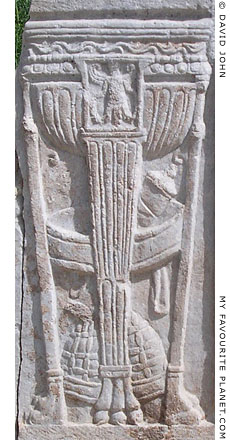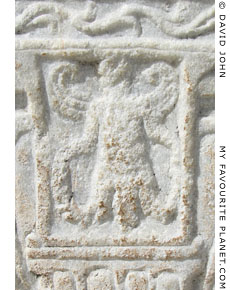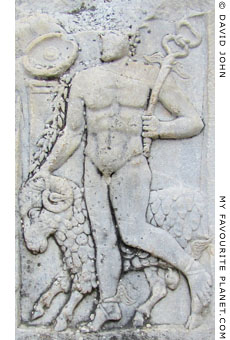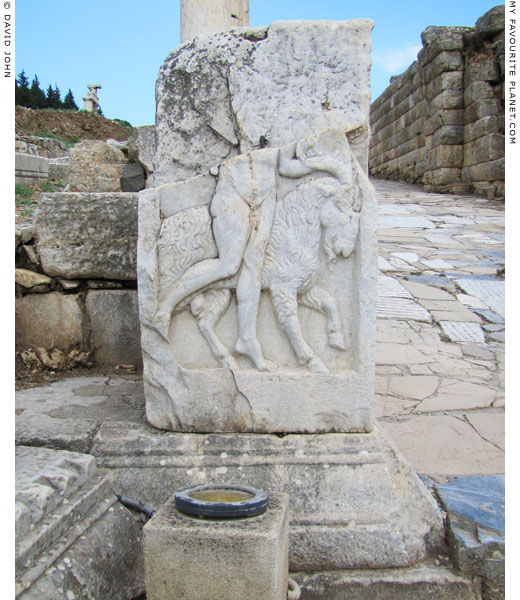|
|
|
| My Favourite Planet > English > Middle East > Turkey > Ephesus > photo gallery |
| Ephesus, Turkey |
Ephesus photo gallery 1 |
 |
 |
12 of 62 |
 |
 |
|
| |
|
| Reliefs on two pedestals at the bottom of the "Clivus Sacer" (Sacred Way), Ephesus |
| |
"Clivus Sacer" - the Sacred Way
The two matching pedestals (bases for statues or pillars?) flank the bottom of the steep street, named "Clivus Sacer" (Sacred Way) by archaeologists, as it descends westwards from the Upper State Agora to Domitian Square, which leads to Kuretes Street down towards the Library of Celsus (see below).
Each pedestal is decorated on the side facing the street with a bas-relief of a tripod, between the lion-claw feet of which is the omphalos, the navel of the world, indicating that it belongs to the Delphic oracle of Apollo (see photo below), the twin brother of Artemis, the patron deity of Ephesus.
Over the central leg of the tripod is a winged figure with sickle-shaped wings, holding animals in its outstretched arms. The figure is badly worn and difficult see, but it appears to be a depiction of the Mistress of Animals (Potnia Theron), a deity associated with Artemis.
The downhill (west) side of each pedestal is decorated with a bas-relief of Hermes leading an animal: the relief on the north side of the street (left as you go up, see photo below) shows him walking to the right with a male goat, and on the south side he walks to the left with a ram. The images of the god are mirrored so that they face each other and the street.
On both reliefs the messenger god is depicted as a naked, athletic youth with winged sandals. In one hand he holds a winged kerykeion (caduceus), his trademark herald's staff or wand entwined with two snakes, which he used to induce sleep and healing. With his other hand he pulls along the reluctant-looking animal by the head. Behind him is a tall altar with a phiale (libation bowl) on top, indicating that the image is concerned with a sacrifice, perhaps to Apollo.
The reliefs may refer to the healing god Asklepios, Apollo's son, and have been associated with an Asklepion or healing centre thought to have been located nearby. Alternatively, they may have been connected with the adjacent Prytaneion, or the Upper Agora.
The pedestals have been dated to somewhere between the 1st and 4th centuries AD (according to one source circa 3rd century AD), which is rather vague, and little seems to have been published about them. On one hand it is wonderful to see them on the street in Ephesus, but strange that they have been left here and not sheltered in the museum. |

The omphalos between the feet
of the tripod of the pedestal
on the north side of the street. |
| |

The Mistress of Animals on
the north pedestal tripod. |
| |

The better preserved of the
Hermes reliefs, on the pedestal
on the south side of the street. |
| |
| |

The view eastwards along the "Clivus Sacer", from Domitian Square up
towards the Upper Agora and the upper entrance of the archaeological site.
|
The step on which the pedestals stand marks the the lower end of the steep street named "Clivus Sacer" (Sacred Way) by archaeologists, which runs west down from the Prytaneion. It was part of the Kathodos (literally, the way down), eastern branch of the Sacred Way, the route of the annual procession during the Artemisia festival [1], which led between the Temple of Artemis to the Magnesian Gate, through the Upper Agora, then down the "Clivus Sacer" and the Kuretes Street, to the Great Theatre.
To the east of the step is Domitian Square, the junction between the two streets leading down from the upper city and the Upper Agora, and Kuretes Street.
To the right (south) are the massive foundations of northwest end of the Upper Agora and the Basilica Stoa. Behind the colonnade to the left (north) were shops, and near the top of the hill stood a long, apsed building of the late antique period, which may have been a chapel or part of a larger complex of buildings.
The steep slope and the uneven, irregular paving slabs makes going difficult, though not impossible, for wheelchair users. |
|
|
| |

The tripod relief on the pedestal on the south side of the Clivus Sacer.
On this relief a snake (python), writhes up from the omphalos
to below the bowl, with its head to the right of the central leg. |
| |

The relief of Hermes with a ram on the south pedestal on the Clivus Sacer. |
| |

The relief of Hermes with a male goat on the north pedestal on the Clivus Sacer. |
| |

Herakles (Hercules, left) steals the tripod from Apollo's temple
in Delphi, with Apollo in hot pursuit.
Fragment of an Archaistic marble relief on a round building element, perhaps a
puteal (well head). End of the 1st century BC - beginning of the 1st century AD.
Said to be from Cumae (Italy). Height 60 cm, width 56 cm, depth 36 cm.
Antikensammlung SMB, Berlin (Pergamon Museum). Inv. No. Sk 894.
From the Bartholdy Collection, Rome. |
| |

An Ionic capital lying upside down on the Clivus Sacer. |
| |
Sacred Way
Ephesus |
Notes, references and links |
 |
|
1. The Sacred Way and the Artemisia festival
The annual festival in honour of Artemis, known as Artemisia or Ephesia, lasted several days. It included sporting and musical competitions and a procession, during which a festively decorated cult statue of Artemis was carried through the city of Ephesus. This was also seen as the visit by the goddess to the city.
Starting from the Temple of Artemis, the procession took the part of the Sacred Way known as the Kathodos (literally, the way down) to the Magnesian Gate at the east of the city, through the Upper City and the Upper Agora, down the "Clivus Sacer" and the Kuretes Street, to the Great Theatre. From there it returned to the temple along the Anados (the way up), via the Theatre Street, leaving the city via the colonnaded street between the Stadium and the Vedius Gymnasium and through the Koressos Gate. |
|
|
Photos, articles and map: © David John,
except where otherwise specified.
Additional photos: © Konstanze Gundudis
All photos and articles are copyright protected.
Images and materials by other authors
have been attributed where applicable.
Please do not use these photos or articles without permission.
If you are interested in using any of the photos for your website,
project or publication, please get in contact.
Higher resolution versions are available on request.
Some of the information and photos in this guide to Ephesus
originally appeared in 2004 on davidjohnberlin.de. |
|
| |
 |
Visit the My Favourite Planet Group on Facebook.
Join the group, write a message or comment,
post photos and videos, start a discussion... |
|
|
| |
|
|
|